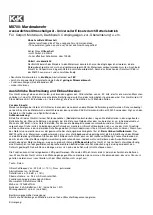
Operator's Manual
WP700Zi-OM-E-RevA
180
Parameter
Description
Definition
Notes
(eovp)
on an eye
scopes.
Eye Pk Noise
(eppn)
Peak-to-peak noise of a level
of an eye diagram
Standard in SDA and WaveExpert
scopes.
Eye PkPk Jit
(eppj)
Peak-to-peak jitter measured
on eye persistence
Standard in SDA and WaveExpert
scopes.
Eye Pulse Wid
(epwid)
The width of the eye
measured at mid level
Standard in SDA and WaveExpert
scopes.
Eye Q Factor
(Q)
Q factor measured within the
eye aperture
Available with SDA and SDM
options.
Standard in SDA, SDA100G, and
WaveExpert scopes.
Eye RiseTime
(erise)
Rise time of the mean of
persistence data
Standard in SDA and WaveExpert
scopes.
Eye RMS Jit
(ermsj)
Root mean square jitter of an
eye
Standard in SDA and WaveExpert
scopes.
Eye SD Noise
(esdev)
The standard deviation of
data on one eye level
Standard in SDA and WaveExpert
scopes.
Eye SgToNoise
(estn)
Signal to noise of an eye
diagram
Standard in SDA and WaveExpert
scopes.
Eye SupRatio
(esupr)
Suppression ratio of an eye
Standard in SDA and WaveExpert
scopes.
Eye Width
(ewdth)
Size of the horizontal
opening of an eye diagram
Available with SDA and SDM
options.
Standard in SDA, SDA100G, and
WaveExpert scopes.
Fall 80-20%
(fall8020)
Fall 80-20%: Duration of
pulse waveform's falling
transition from 80% to 20%
of the amplitude, averaged
for all falling transitions
between the cursors.
Average duration of falling
80-20% transition
On signals not having two major
levels (triangle or saw-tooth waves,
for example), top and base can
default to maximum and minimum,
giving, however, less predictable
results.
Standard parameter.
Fall time
(fall)
Fall time: Duration of falling
edge from 90-10% of
amplitude.
Time at upper threshold
minus
Time at lower threshold
averaged over each
falling edge
On signals not having two major
levels (triangle or saw-tooth waves,
for example), top and base can
default to maximum and minimum,
giving, however, less predictable
results.
Standard parameter.
Fall@level
(fall@lv)
Fall at level: Duration of
pulse waveform's falling
edges between user-
specified transition levels.
See also
Rise@level
.
Transition time for % or
absolute levels of all
falling edges.
Enhanced version sets
measurement calculations
to use one of the
following:
On signals not having two major
levels (triangle or saw-tooth waves,
for example), top and base can
default to maximum and minimum,
giving, however, less predictable
results.
Standard parameter.
Summary of Contents for DDA 7 Zi series
Page 1: ...Operator s Manual WavePro SDA and DDA 7 Zi Series Oscilloscopes ...
Page 2: ... L R R H HUD RU D D ...
Page 41: ...Operator s Manual WP700Zi OM E RevA 40 The detachable WavePro Zi front panel ...
Page 376: ...WavePro 7Zi 375 WP700Zi OM E RevA Absolute Offset Relative ...
Page 439: ...Operator s Manual WP700Zi OM E RevA 438 ...
Page 440: ...WavePro 7Zi 439 WP700Zi OM E RevA ...
Page 544: ...Thank you for purchasing a WavePro SDA or DDA 7 Zi Oscilloscope ...
















































